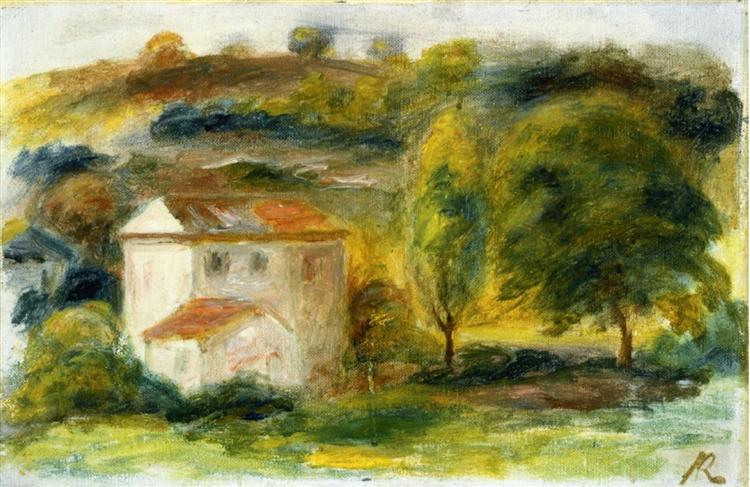Description
Pierre-Auguste Renoir's painting "Landscape with the White House" (1916) is a work that encapsulates not only the artist's distinctive aesthetic, but also his stylistic evolution and the context in which it was made. In this landscape, Renoir exhibits his mastery of capturing light and color, using a technique that reveals his commitment to Impressionism and his transition to a greater contemplation of the environment.
The work presents a serene scene that evokes a sense of peace and natural eloquence. At the center of the composition is the White House, whose presence blends harmoniously into a rural landscape. This depiction conveys an intimate connection between architecture and nature, where the soft tones of the building contrast with the vibrant greens of the surroundings, a common practice in Renoir’s work. The way the house is incorporated into the composition, surrounded by trees and vegetation, highlights his characteristic use of color to capture the sunlight filtering through the leaves, creating a play of shadow and light that is a signature of Impressionism.
Colour is one of the most striking aspects of this work. Renoir uses a rich, warm palette, with greens, yellows and whites predominating, creating a bright and cheerful atmosphere. The loose application of paint, which can be seen in the visible brushstrokes, produces a texture that almost evokes the movement of the wind caressing the landscape. This treatment of colour and light is fundamental to the work of the artist, who always sought to immortalise the beauty of everyday life and the subtleties of nature.
In terms of the human figure, Landscape with the White House departs from many of Renoir's earlier compositions that often included social gatherings or portraits. Here, the absence of human characters allows the viewer to focus on the interplay between architecture and nature, inviting them to immerse themselves in the tranquility of the landscape. This approach also suggests a contemplative meditation, where the landscape becomes a refuge for introspection, as opposed to the vibrant social life that traditionally populated his works.
Renoir’s work from this period resonates with a desire for escape into the natural and serene, a yearning that was particularly significant in the years following World War I. In this sense, “Landscape with the White House” can be interpreted not only as a depiction of a specific place, but as a reflection on the peace and stability that many sought in tumultuous times. Renoir’s ability to capture the essence of a moment and revitalize it through his work is what makes him stand out as a master of Impressionism.
In short, Landscape with the White House from 1916 offers not only a retouching of Renoir’s aesthetic, but also a window into his artistic soul at a momentous time in his career. The work is a testament to the beauty of the natural world and an evocation of the serenity we all crave. The technique, use of color, and absence of human figures combine to create a visual experience that encourages contemplation and appreciation of simplicity in the environment, highlighting Renoir’s unrivaled ability to capture light and a sense of place.
KUADROS ©, a famous painting on your wall.
Hand-made oil painting reproductions, with the quality of professional artists and the distinctive seal of KUADROS ©.
Painting reproduction service with satisfaction guarantee. If you are not completely satisfied with the replica of your painting, we will refund 100% of your money.

